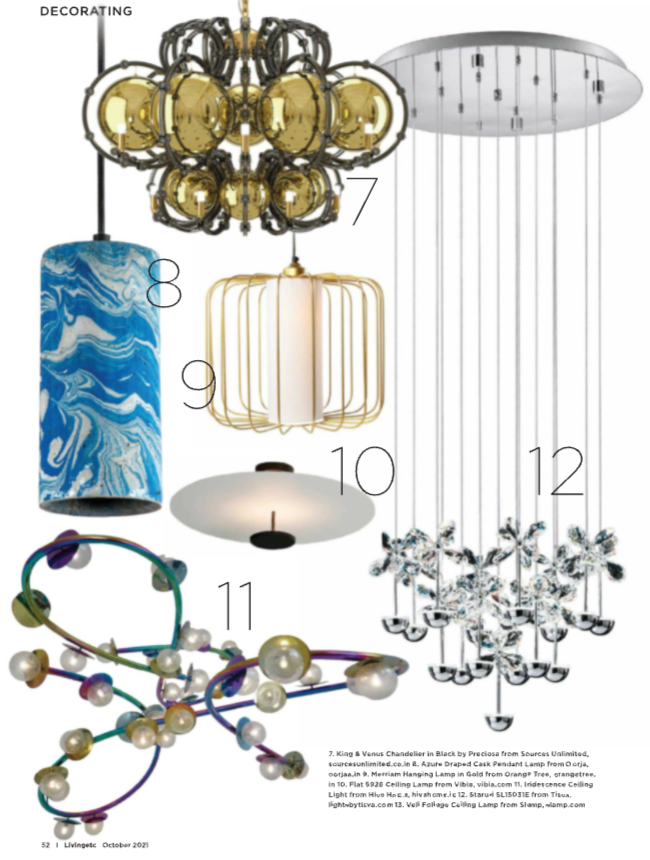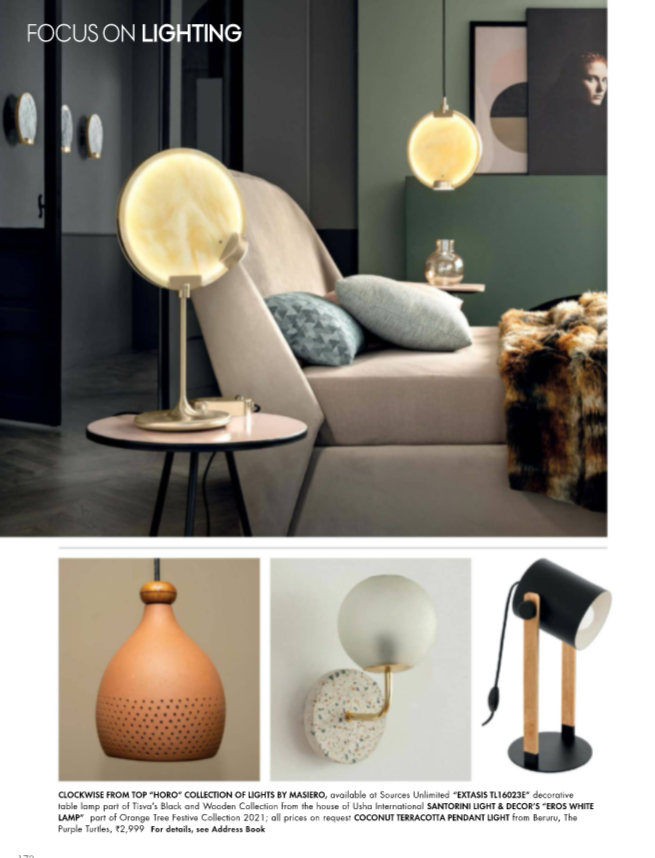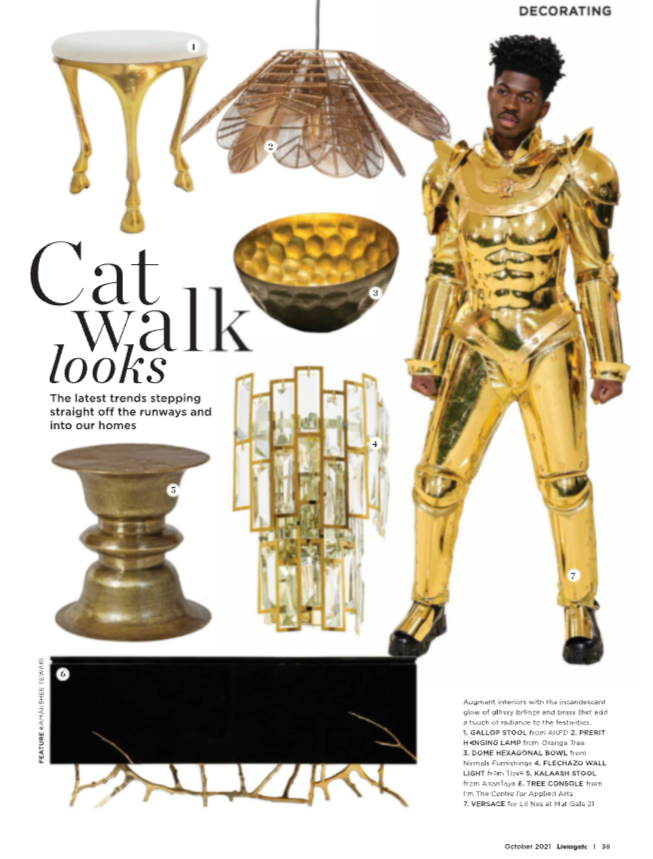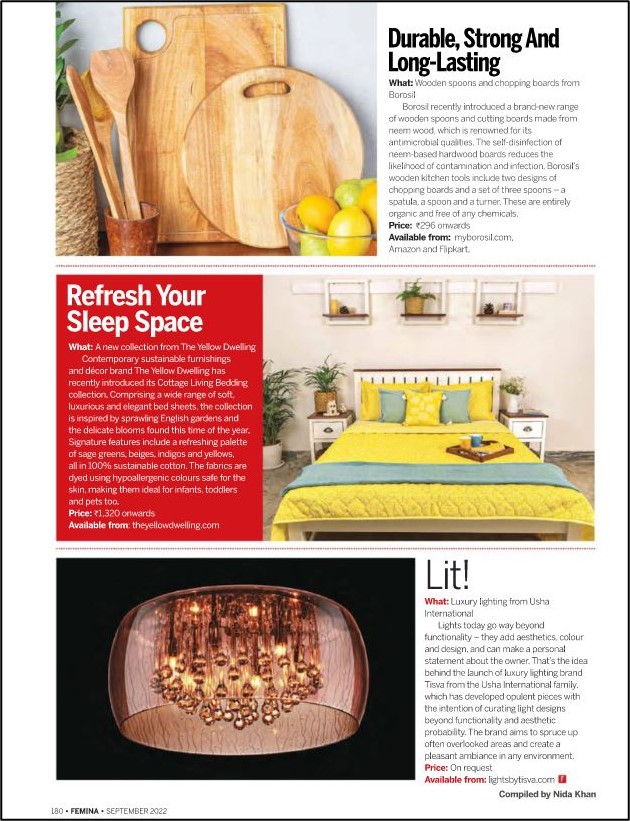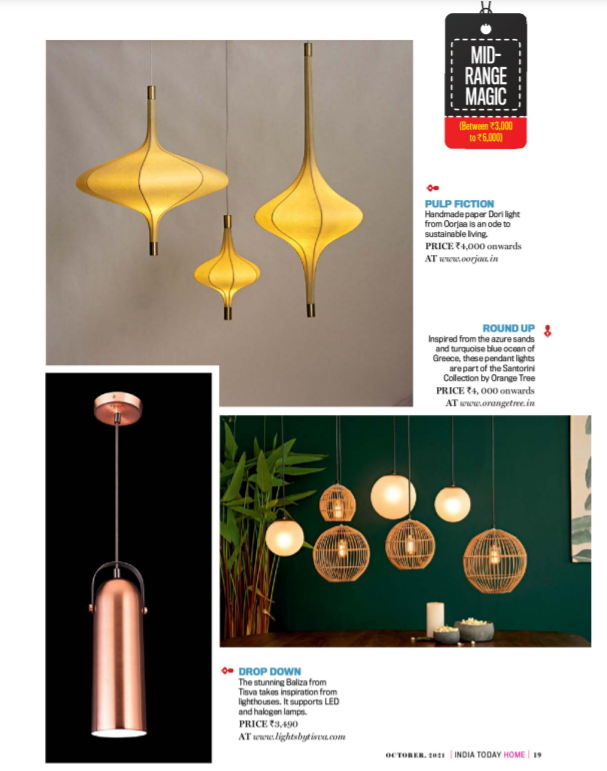We all know what Brightness is. However, let’s get a bit technical: In the world of Lighting Design, specifying the direction and distribution of light in a space yields Brightness contrast. Simply put determining the intensity and spread of light over an area results in Brightness levels.
Brightness vs Luminance
We often use the terms Brightness and Luminance synonymously, which is incorrect. Brightness is a subjective term that refers to the sensation of light observed by human consciousness. Luminance on the other hand, is a technical term that objectively measures intensity of light per unit of the projected space.
Direction and Distribution of Light
A Lighting feature or a Luminaire can emit light in one of the following three directions – upward, downward or multidirectional. And it has two ways of distributing light, either it can be concentrated or diffuse/spread.
When Luminaries emit light downwards, it has a restricted angular spread. Both due to this restricted spread and the position of the human eyebrow, this kind of light do not have a direct glare. Upward light covers a much larger area of the ceiling; the light reflected from the ceiling is of low luminance and is unlikely to cause distracting glares. Multidirectional light is emitted in all directions and very often the light which is directed sideways cause objectionable glares.
Upward and Downward light falls in patterns. If the light is concentrated the focused pattern is narrow and if the light is diffuse it casts a wide pattern.
Luminaries with narrow beams that lack an upward component of light (doesn’t cast any light upwards) focus concentrated light downwards. This type of light is called direct light. When such lights are placed on low ceilings, the focused direct light (with a spread of 30 degrees or less) creates areas of high luminance on the floor with dark areas in-between. To avoid this, a number of narrow beam luminaries needs to be placed closely together. Thus if you have a low ceiling it is better to use diffuse downward light rather than concentrated downward light.
When the same narrow beam luminaries are placed on a high ceiling, the concentrated beams of direct light overlap each other and thereby dark areas are avoided. However, they only manage to light up horizontal spaces and the top of objects; where faces and walls receive very little light, remaining in shadows and comparative darkness. This kind of space is called a high-contrast space, where the overall ambient light is low but feature bright accents.
Wide beam downward luminaries cast a diffuse downward light, spread over a larger area –generally the spread is between 80 to 120 degrees. This is a much more practical distribution of light, with most Downlighters having a spread of 100 degrees. Such luminaries light up vertical spaces and faces creating a low-contrast space.

An upward (also termed as indirect) beam of concentrated light, will make the ceiling prominent, which also becomes a secondary source of light as it reflects back light. When such a light is placed near the ceiling, it will create isolated areas of brightness or high luminance. If these are the only source of light in the room, it will give rise to non-uniform spots of brightness on the ceiling which will cause glare and are uncomfortable. When similar light sources are placed further away from the ceiling, it lights up the ceiling uniformly, as their beams overlap and the spread increases. Thus high ceilings are more likely to avoid uncomfortable glares.
Concentrated upwards beams of light near the ceiling when used together with concentrated downward beams, removes the high contrast factor of the latter. This type of lighting creates spaces of visual interest as seen in exhibitions and museums.
A diffuse upward light will light up both the ceiling and the upper parts of the wall. This type of lighting causes uniform glare free luminance and is generally used near Video Display Terminals. They can also be used to highlight decorative features near or on the ceiling. Since every part of the ceiling reflects back light uniformly, this system creates a low-contrast environment, where objects have a washed-out appearance as in an overcast day.
A multidirectional diffuse luminary casts light both upwards and downwards. The reflected light from the ceiling overlaps with the downward beams of light reducing shadows and contrasts, creating uniformly lit rooms. Luminaries that cast both downwards and upwards light, but not sideways are called direct/indirect. These systems light up the work surface and reduce contrasts.
Multidirectional concentrated light are of two types semi-direct and semi-indirect. The former happens when 60 to 90% of the light is delivered downwards. Similarly if 60 to 90% of light is delivered upwards it is called semi-indirect. A high-contrast non-uniform setting is created when both upward and downward lights are concentrated. When the light reflected from the wall and ceiling is insufficient it cannot uniformly counter the direct and indirect beams of light, thereby creating an environment of Moderate contrast.
Vertical Surface Illumination
Wall lighting can at times be used as a substitute for indirect ceiling lighting (luminaries directing light upwards). As against indirect ceiling lighting it lightens shadows and excessive contrast. It works best when the walls are high in comparison to the room. Another option for indirect ceiling lighting is direct downlighters over a light-colored floor. In this technique the floor will reflect back the light upwards, but the floor must be kept clean and clear for this purpose.
The ideal arrangement is a combination of direct and indirect lighting, where the direct lights acts as a sun casting shadows and modeling shapes, while the indirect light softens these shadows. Direct/Indirect arrangements can either be made through separate lights (individual upward and downward lights) or through single luminaries that throw light both upwards and downwards.
Surface Finishes and Reflectance
What we perceive as brightness is not the light on the surface of an object, but the light that is reflected by that surface. This in turn differs from object to object with the intensity of brightness depending on the properties of a surface (i.e Brass vs. Ceramic). When a room is lit, a little light falls on all surfaces, which is then reflected back. The relative size and intensity of the reflected light from these surfaces/objects determine their prominence, thereby influencing the interior composition/decor of the room.
Reflected light is generally diffuse and multidirectional in nature, which causes it to overlap with other light and inter-reflect from nearby surfaces. This kind of inter-reflection covers up shadows, reduces contrasts and results in uniform brightness. Thus the overall Brightness of a room is dependent on inter-reflections and thereby on the nature of surfaces reflecting them, also known as Reflectance of a surface.
Dark coloured objects/surfaces reflect very little light and create a high-contrast space, even if the room is lit up (regardless of the amount of luminance present.) Light coloured surfaces and high reflectance finishes reflect much more light and also experience more inter-reflections. This leads to higher brightness and more diffusion/spread of light. It must be noted that the inter-reflection is independent of the initial distribution of light, be it concentrated or diffuse.
Thus choices of surfaces have the tendency to change the initial distribution of light and hence should be taken into account while designing a lighting system.
Secondary Light Sources
Any object or surface that reflects or transmits back light is a Secondary Light source. The moon is one such source. Just like moonlight, ceilings or walls that reflect back light can be considered as secondary sources of light.
Three Dimensional Forms
The direction and distribution of light also affect how we view surfaces and objects in their three dimensional form. All three-dimensional objects are seen as pattern of brightness contrast consisting of brightness and shadows. (For example adding shadows and highlighting certain parts of a drawing on paper will make it appear to be 3D.) Thus, if one alters the direction in which light falls on the object/surface we will perceive it differently.
Similarly lighting also alters the perception of textures. If the light source is located close to a texture (also known as Grazing light) it will amplify the highlights and shadows of the texture. Grazing light is apt for lighting up textured surface (masonry , plaster or concrete walls).Using Grazing light on flat or smooth surfaces will highlight its imperfections in form of blemishes and marks that may be present on the surface, and therefore is not recommended. Using diffuse wash light on wall surfaces tend to hide these imperfections and is recommended for gypsum wall or acoustical tile ceiling. It works best when used from the front of the surface.
Concentrated direct light adds drama and emotional excitement to objects and surfaces, but at the same time it tends to hide a few details of the concerned object. It works great when used in museums props, but if one were to study the object accurately it needs to be lit up using diffuse light that illuminates the entire object.
Sharp highlights and dark shadows also add to drama, since they light up textures and bring into focus certain parts. However this can be distracting in a working environment – for example the shadow of a pencil or hand while writing under a concentrated source of light cast by a table lamp. If such shadows appear in say an assembly line of a factory, it can prove very disastrous. Hence diffuse light distribution that minimizes shadows and highlights is suitable for all work surfaces.
However, shadows and highlights used in the right way are desirable in a working environment, since they provide visual relief and interest. Workers both in offices and factories benefit from brightness contrast used in the building’s lounges, corridors, washrooms and other meeting places.
We know that memory and experience also influence the way we perceive the world. For example we expect the midday sun to be overhead every day. Altering the direction and place of light from the normally expected place will also give rise to unusual shadows and highlights. These together will create unnatural impressions and arouse feelings of mystery and anxiety.
In practice objects being lighted or photographed are lighted from two sides. One side illuminates with concentrated light like the sun and adds drama. While the other side uses diffuse light like the sky to hide the shadows that may have been created by the former. Adding another source of light in the background will separate the object from its surroundings making it more distinct.
Glare and Sparkle
Excessive brightness is called Glare, where extreme glare can reduce our vision. Most of the time Glare is confused with ‘too much light’ when in reality Glare is caused due to light coming from the wrong direction. For instance the light from incoming car headlights – thus glare is a caused by excessive light in the wrong direction. At the same time this example also illustrates that Glare can exist with very little light – the car headlights are not excessively bright.
Glare is also related to the area concerned (luminance area): If excessive light is used over a small area, it is tolerable. Now, if the same amount of light is used over a larger area it becomes intolerable. The human eyebrow protects us from glares made by overhead luminaries, but not from luminaries or high reflective surfaces located on the walls, as they fall directly in our field of view.
Direct Glare
The late afternoon sun and an unshielded electric light are two examples of Direct Glare. It can be defined as excessive light misdirected towards our eyes. Generally exposed bare lamp (the technical name for a light bulb) cause glares and hence are avoided by architects.
Direct Glare can be controlled in three different ways: 1. Limit the amount of light emitted towards the eye. This can be done by shielding the device/source (the cap on a sunny day). 2. Increase the area of the light source (i.e a white glass globe or diffusing panels around the bulb). 3. Changing the direction of the light. This is effectively done by automobiles, by lowering the direction of light emitted by the headlights. Reflecting and refracting lenses along light sources can be used for this purpose.
Visual comfort is achieved by reducing, glares and distracting luminance.
Visual Comfort Probability (VCP)
A Visual Comfort Probability (VCP) rating is defined as the percentage of people who if seated at the least desirable location in the office will find suitable illumination. It depends on light sources, surfaces and the shape of the room. Generally a rating of 70% is recommended and 80% if the office features Video Display Terminals. This rating system is applicable only to direct lighting systems.
Reflected Glare
Visual Comfort is not only dependent on Direct Glare but also on Reflected Glare. Reflected Glare can be defined as excessive illumination (glare) reflected from surfaces and objects in our field of view. The most prominent among these are Specular surfaces that reflect light unto a broad area in many directions. The light reflected back is generally the mirror image of the light source or of any other lighted surface in the view area.
These surfaces make for very good reflectors. But bad for interior design – as polished or specular surfaces like desks, floors and walls will reflect back uncomfortable glare. Reflected Glare on glass and other transparent surfaces become visual barriers at times – for example it turns large areas of glass into black mirrors at night.
It is wise to remove glossy and specular surfaces at task areas to avoid distraction. Think of the task surface as a mirror while setting up a light system around it. For instance when luminaries are lit on either side of a work desk, the shadow casts by them are filled in and light is reflected away from the worker’s eye.
Video Display Terminals (VDTs)
Initially VDTs were a major problem as they reflected back light from their screens. Today with the help of low-reflectance screens such as Flat Screen Display, LCDs etc this is no longer a problem. The apt way to solve a VDT problem earlier was to put blinds on the light source, wear darker clothing, change the angle of the screen etc. Sometimes the ambient lights in VDT rooms were set low to resolve this problem. Though this ensured less room reflection, it made the room gloomy and un-stimulating.
Sparkle
The difference between Glare and Sparkle is one of area and magnitude. Where large areas of high luminance (Glare) are disturbing, smaller areas of similar luminal intensity are points of sparkle. They add highlights and arouse emotional excitement. There are three types of Sparkles, which are best understood by the following examples:
Direct Sparkle: Examples include Christmas Tree and Diwali Lights. Small, exposed clear filament bulbs and perforated shielding materials (materials with small pin-holes shielding the light source).
Reflected Sparkle: Examples include textured materials (textured metallic wall coverings) and pebbled surface finishes that reflect back light
Transmitted Sparkle: Examples include Crystal Chandeliers, Glitter, frosted diffusers around bulbs.The presence of sparkles, highlights and shadows are chief visual attributes that excite us emotionally and make the environment visually exciting. The presence of these attributes turn a sunny day stimulating and exciting, as against a gloomy overcast flat day. Similarly their addition indoors tends to influence and lift our moods.


